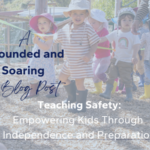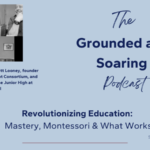Dear MMS Community:
“I do not believe there is a method better than Montessori for making children sensitive to the beauties of the world and awakening their curiosity regarding the secrets of life.”
Gabriel Garcia Marquez, Montessori Alumnus and Nobel Prize Laureate
Last September, at the end of his second week as a new Marin Montessori student, I took my son out for dinner to his favorite spot. “So, Buddy,” I asked as he chomped away, “What’s the biggest difference between your old school and MMS?” He looked up at me, swallowed, and with sauce dripping down his chin pronounced, “Marin Montessori makes you want to learn.”
For me, this is an unforgettable moment from 2016: It makes my heart sing that my twelve-year-old son strives to learn and finds fulfillment in asking questions, exploring for answers, making discoveries, and sharing what he learns. I know that if my sons approach their lives as adventurous opportunities to discover, grow, and share, then theirs will be fascinating, fulfilling, and helpful lives indeed. Additionally, I understand that today the most valuable habits of mind and capacities I can hope my children develop are a thirst for knowledge and the skills with which to apply their learning to innovate.
The U.S. Department of Labor published a report in which it forecasted that sixty-five percent of the careers our children will experience have not even been invented yet. Why is this? Through globalization, the world has become “flat,” and the rapidity with which technology disrupts and develops is breathtaking. Jobs that can be automated have been and will continue to be, and while the 20th century industrial model of conventional education—namely, children of the same biological age being instructed in the same content knowledge at the same time in the same way—helped develop citizens who could memorize and repeat information and comply with instructions, these are not the most crucial qualities, especially for the 21st century. As a recent article in Foreign Affairs argues, because so much of human labor is becoming automated, in the near future, “…those who can innovate and create…” are the ones who will flourish. This is good news for our families: Everything we do at Marin Montessori cultivates both substantive knowledge and inner discipline—foundational necessities for robust creativity and innovativeness—and a thirst for understanding, problem solving, and creating.
In fact two studies from this past decade (“Creative Giftedness and Educational Opportunities” and “Differences in the Development of Creative Competencies in Children Schooled in Diverse Learning Environments“) conclude that Montessori environments like ours are superior in developing capacities for creativity. And this creative aptitude is not limited to the toddler, primary, and elementary years. During adolescence, a time when school engagement among students typically wanes, junior-high-aged students attending Montessori schools demonstrate significantly higher rates of motivation, interest and enjoyment in learning. If educator Sam Pabon is right, that as educators we should “…help cast a vision for students that will not only stretch their imaginations, but also their beliefs regarding what is possible…” then our ability to keep the fires of curiosity and creativity burning brightly in our MMS students is likely one of the greatest gifts we give.
How do we do it?
Because our outstanding faculty emphasize presentation of materials in sequential steps and carefully guide students in constructing knowledge in geography, art, music, science, history, language, and math, MMS students develop the foundational necessities to know how to powerfully create. A common myth is that creativity arises from chaotic free expression. Yet as Sir Ken Robinson shows in his book, Out of Our Minds: Learning to be Creative, this is not the case. In fact, we need knowledge and an understanding of how reality operates to then create and innovate something new and useful. Consider artists Braque and Picasso, who amazed the world with their Cubism only after years devoted to achieving the ability to paint realistically. The cornerstone qualities of MMS students’ learning experiences are ideal for promoting robust, innovative thinking and creation. As the “Education Scotland” organization reported after they commissioned a review of research and policy articles on fostering creativity in schools, there are four key features in schools that most ably promote ingenuity: 1) Students are offered more autonomy of learning and ownership of the work; 2) students learn in physical environments that are varied, from indoors to outdoors, and to locations outside of school; 3) students are offered appropriate degrees of flexibility in how they use their time; and 4) students are encouraged to work at the level of challenge that is appropriate to each individual. Together, these four essential features for cultivating creativity describe perfectly our MMS approach to educating children and adolescents.
It is no wonder then that Harvard Business Review published a piece titled, “Montessori Builds Innovators” and that Peter Sims wrote in The Wall Street Journal that “…the Montessori educational approach might be the surest route to joining the creative elite, who are so overrepresented by the school’s alumni that one might suspect a Montessori Mafia: Google’s founders Larry Page and Sergei Brin, Amazon’s Jeff Bezos, videogame pioneer Will Wright, and Wikipedia founder Jimmy Wales, not to mention Julia Child and rapper Sean “P.Diddy” Combs.” (I’ll also mention Steph Curry—whose mother also heads a Montessori school—and cellist Yo-Yo Ma as other Montessori alumni favorites of mine.)
Dr. Montessori led a remarkable and remarkably innovative life: at age thirteen she gained entrance to an all-boys technical school to study engineering, later went on to become one of the first female physicians in Italy, and by the end of her life had been nominated for the Nobel Peace Prize on three different occasions. Dr. Montessori would no doubt be proud that the likes of the founders of Google and Amazon credit their Montessori education for inspiring their habits of mind and creativity in technology and business, and, her most pressing concern was to bring peace to the highly conflicted world in which she lived. The year 2016 revealed that humanity and our country itself still has much work to do to unify our fragmented parts. Albert Einstein noted once that, “The world we have created is a product of our thinking. It cannot be changed without changing our thinking,” and indeed, it will require great ingenuity on our and our children’s part to solve the most vexing modern challenges. In this new year, may it be our collective aspiration as a Marin Montessori community that we continue to so ably support our children and adolescents in developing the sharp intellects, creative minds, and wise hearts that will serve them well in their lives, guiding them to become adults with the capacity to create solutions, contribute beneficially, and flourish.
With warmest New Year’s wishes to you and yours,
Sam




